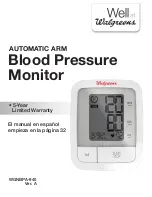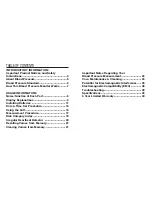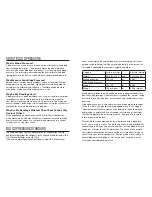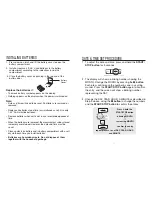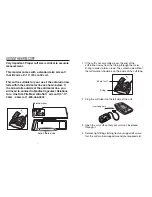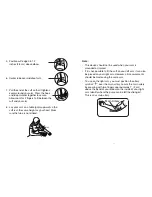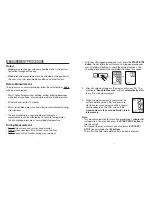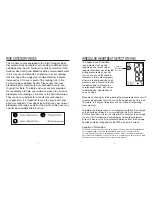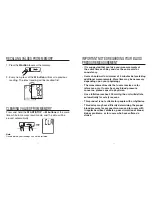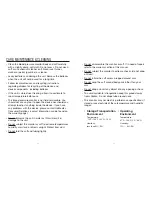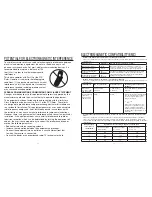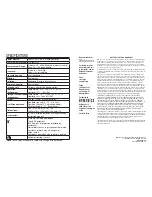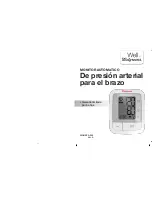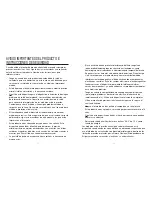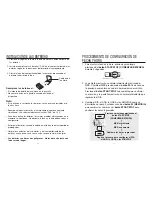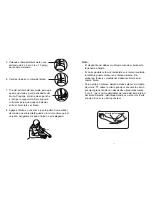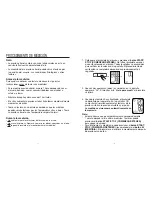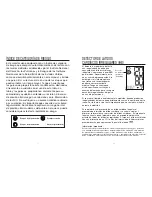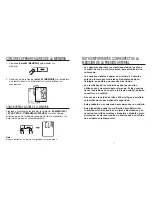
25
26
POTENTIAL FOR ELECTROMAGNETIC INTERFERENCE
To avoid inaccurate results caused by electromagnetic interference between
electrical and electronic equipment, do not use the device near a cell
phone or microwave oven. For most wireless communication devices, it is
recommended to maintain a distance of 10.8
feet (3.3m) in order to avoid electromagnetic
interference.
This device complies with Part 15 of the FCC
Rules. Operation is subject to the following two
conditions: (1) this device may not cause harmful
interference, and (2) this device must accept any
interference received, including interference that
may cause undesired operation.
FEDERAL COMMUNIATIONS COMMISSION COMPLIANCE STATEMENT
Changes or modifications to this equipment not expressly approved by the
manufacturer could void the user’s authority to operate the equipment.
This equipment has been tested and found to comply with the limits for a
Class B digital device, pursuant to Part 15 of the FCC Rules. These limits
are designed to provide reasonable protection against harmful interference
in a residential installation. This equipment generates, uses and can radiate
radio frequency energy and, if not installed and used in accordance with
the instructions, may cause harmful interference to radio communications.
However, there is no guarantee that interference will not occur in a particular
installation. If this equipment does cause harmful interference to radio or
television reception, which can be determined by turning the equipment off
and on, the user is encouraged to try to correct the interference by one or
more of the following measures:
• Reorient or relocate the receiving antenna.
• Increase the separation between the equipment and receiver.
• Connect the equipment into an outlet on a circuit different from that
to which the receiver is connected.
• Consult the dealer or an experienced radio/TV technician for help.
ELECTROMAGNETIC COMPATIBILITY (EMC)
• Guidance and manufacturer’s declaration – electromagnetic emissions
The device is intended for use in the electromagnetic environments listed below, and should only be used in such
environments:
Emissions test
Compliance
Electromagnetic environment – guidance
RF emissions CISPR 11
Group 1
RF energy is used only to maintain device’s operation.
Therefore, its RF emissions are so low that it’s not likely to
cause any interference in nearby electronic equipment.
RF emissions CISPR 11
Class B
Harmonic emissions IEC
61000-3-2
Not
Applicable
The device is suitable for use in all establishments, including
domestic establishments, and those directly connected to
the public low-voltage power supply network that supplies
buildings used for domestic purposes.
Voltage fluctuations/ flicker
emissions IEC 61000-3-3
Not
Applicable
• Guidance and manufacturer’s declaration – electromagnetic immunity
The device is intended for use in the electromagnetic environments listed below, and should only be used in such
environments:
Immunity test
IEC 60601 test level
Compliance level
Electromagnetic environment–
guidance
Electrostatic
discharge (ESD)
IEC 61000-4-2
± 6 kV contact
± 8 kV air
± 6 kV contact
± 15 kV air
The relative humidity should be at
least 5 %.
Power frequency
(50/60 Hz)
magnetic field
IEC 61000-4-8
3 A/m
30 A/m
Power frequency magnetic fields should
be at levels characteristic of a typical
location in a typical commercial or
hospital environment.
I
r = --------- (m)
188
Where I is the current in ameres in a
power bus or an appliance wire and r
is the recommended seperation
distance between your device and
the power bus or application wire, in
meters (m).
• Recommended separation distances between portable and mobile RF communication equipment and the
device.
The device is intended for use in an electromagnetic environment where radiated RF disturbances are under
control. User can help prevent electromagnetic interference by keeping the device at a minimum distance from
portable and mobile RF communications equipment (transmitters). Below table details the maximum output power
of transmitter:
Rated maximum
output power of
transmitter W
Separation distance according to frequency of transmitter m
150 kHz to 80 MHz
Not Applicable
80 MHz to 800 MHz
d = 1.2
800 MHz to 2.5 GHz
d = 2.3
0.01
NA
0.12
0.23
0.1
NA
0.38
0.73
1
NA
1.2
2.3
10
NA
3.8
7.3

